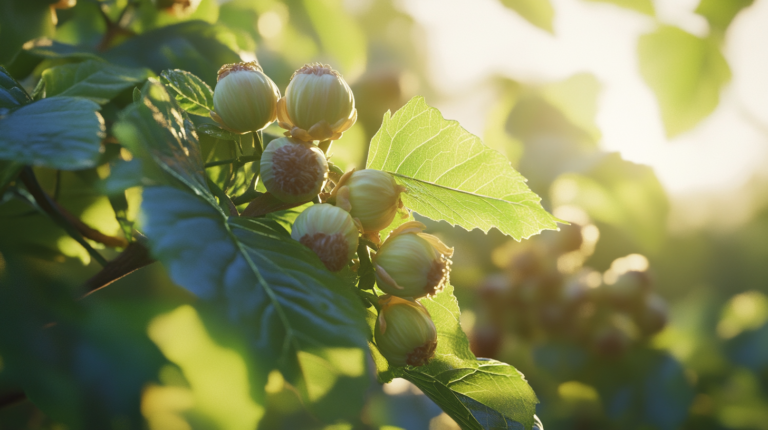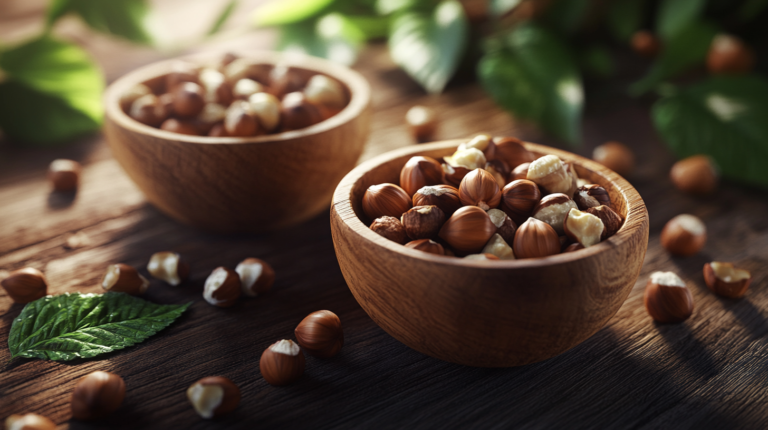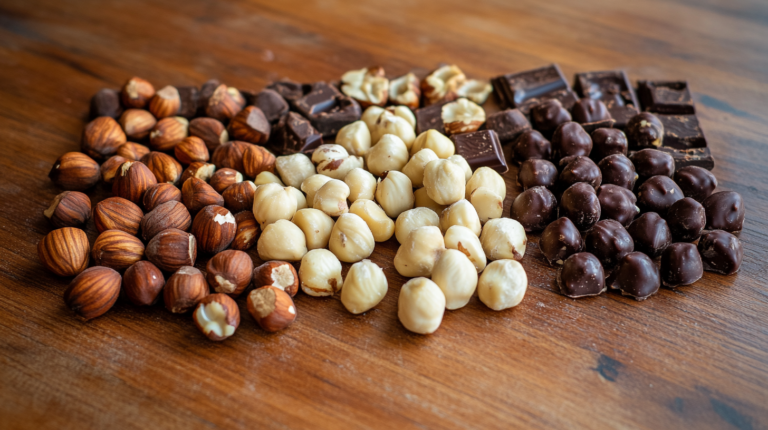The Most Profitable Hazelnut Varieties for Farmers
In recent years, hazelnut farming has emerged as a lucrative agricultural venture, with growing global demand and expanding production regions. For farmers looking to maximize their profits in this industry, selecting the right hazelnut varieties is crucial. This comprehensive guide explores the most profitable hazelnut varieties, considering factors such as yield, disease resistance, market demand, and adaptability to various growing conditions.
European Hazelnut (Corylus avellana)
The European hazelnut remains the cornerstone of commercial hazelnut production worldwide, dominating the market with its large nuts and high-quality kernels12.
– Barcelona
Barcelona is one of the oldest and most widely cultivated hazelnut varieties, known for its reliability and consistent performance2.
+ Characteristics:
- Large, round nuts with thick shells
- Sweet flavor and high oil content
- Ideal for confectionery and roasting
+ Cultivation:
- Thrives in temperate climates with well-drained soils
- Requires cross-pollination, often paired with Daviana and Ennis varieties
While Barcelona has been a staple in the industry, newer varieties with improved disease resistance are gradually replacing it in some regions.
– Ennis
Ennis is a popular variety, particularly in the United States, known for its attractive appearance and favorable market acceptance2.
+ Characteristics:
- Large, slightly elongated nuts with smooth, shiny shells
- Flavorful kernels with appealing aesthetics
- Popular in the nut trade
+ Cultivation:
- Well-suited to the Pacific Northwest region of the United States
- Requires cross-pollination, commonly with Barcelona and Butler varieties
Ennis remains a profitable choice for farmers targeting high-end markets and consumers who prioritize nut appearance.
– Tonda Gentile delle Langhe
This Italian variety is highly prized in the confectionery industry, commanding premium prices due to its exceptional quality2.
+ Characteristics:
- Small to medium-sized nuts with thin shells
- High kernel-to-shell ratio
- Fine flavor and texture
+ Cultivation:
- Primarily grown in the Piedmont region of Italy
- Prefers well-drained, fertile soils and mild climates
- Requires cross-pollination with varieties like Tonda di Giffoni
For farmers with suitable growing conditions, Tonda Gentile delle Langhe can be extremely profitable due to its high market value.
Hazelnuts are cultivated in various regions around the world, each offering unique varieties with distinct flavors.
Disease-Resistant Varieties
Eastern Filbert Blight (EFB) has been a significant challenge for hazelnut farmers, particularly in North America. The development of resistant varieties has revolutionized the industry, allowing for expansion into new growing regions and improved profitability12.
– Jefferson
Jefferson is a relatively new variety that has quickly gained popularity among farmers due to its disease resistance and high yield potential25.
+ Characteristics:
- Medium to large nuts with high-quality kernels
- Very high resistance to Eastern Filbert Blight
- Good yield potential
+ Cultivation:
- Well-suited to the climate of the Pacific Northwest
- Partially self-fertile but benefits from cross-pollination with varieties like Yamhill and Eta
Jefferson’s combination of disease resistance and nut quality makes it a top choice for farmers looking to minimize crop losses while maintaining marketability.
– Yamhill
Yamhill is another standout variety from Oregon State University’s breeding program, offering total resistance to EFB along with other desirable traits5.
+ Characteristics:
- Complete resistance to Eastern Filbert Blight
- Compact growth habit
- Large, delicious nuts
- High productivity
+ Cultivation:
- Popular among commercial growers, including organic farmers
- Adaptable to various soil types
Yamhill’s disease resistance and high yield potential make it an excellent choice for farmers looking to maximize profitability while minimizing pest management costs.
– McDonald
Named after a renowned Oregon grower, McDonald combines disease resistance with qualities sought after in the kernel market5.
+ Characteristics:
- Very disease resistant
- High kernel fill rate (51% compared to Barcelona’s 42%)
- Aimed at the kernel market
+ Cultivation:
- Suitable for organic farming methods
- Efficient producer for farmers targeting processed nut markets
McDonald’s high kernel fill rate can translate to increased profits for farmers, especially those selling to processors rather than the in-shell market.

Varieties for Specific Markets
Different markets and end-uses require specific nut characteristics. Farmers can increase their profitability by targeting these niche markets with appropriate varieties.
– Wepster
Developed specifically for the chocolate and baking industry, Wepster offers traits valued by food manufacturers5.
+ Characteristics:
- Kernels ranging from 11-13 millimeters
- Kernel weight is 47% of total nut weight
- High resistance to Eastern Filbert Blight
- Natural growth habit requiring minimal training
+ Cultivation:
- Ideal for organic orchards
- Suited for farmers supplying the food processing industry
Wepster’s specific traits make it a profitable choice for farmers with established relationships with food manufacturers or those looking to enter this market segment.
– Sacajawea
This variety is known for its exceptional flavor, making it a favorite among gourmet and specialty markets5.
+ Characteristics:
- Abundant crops of flavorful nuts
- Similar to prized Italian varieties
- Somewhat less resistant to EFB than other newer varieties
+ Cultivation:
- Performed well in Oregon trials
- May require more careful management in organic systems
For farmers targeting high-end or specialty markets, Sacajawea’s superior flavor profile can command premium prices, offsetting any additional management requirements.
Considerations for Maximizing Profitability
When selecting hazelnut varieties for maximum profitability, farmers should consider several factors beyond just the characteristics of individual varieties:
– Climate Adaptability
As climate change continues to impact agricultural regions, selecting varieties that can withstand changing weather patterns is crucial3. Farmers should consider:
- Frost tolerance
- Drought resistance
- Adaptability to local soil conditions
– Disease and Pest Resistance
While EFB resistance is a primary concern, other pests and diseases can also impact profitability3. Varieties with broader resistance profiles, such as York (resistant to EFB, bud mite, and kernel mold), can help reduce management costs and crop losses5.
– Market Demand and Trends
Staying attuned to market trends is essential for long-term profitability. Current trends include:
- Increasing demand for plant-based and dairy alternatives
- Growing interest in gourmet and specialty nut products
- Expanding markets in Asia and the Middle East3
Farmers should select varieties that align with these trends to ensure sustained demand for their crops.
– Pollination Requirements
Many hazelnut varieties require cross-pollination for optimal yield. Including pollinizer varieties like Eta can help maximize orchard productivity5. Farmers should plan their orchards to ensure proper pollination for their main crop varieties.
– Organic Farming Potential
With the growing demand for organic products, varieties well-suited to organic farming methods can offer increased profitability. Disease-resistant cultivars like Jefferson, Yamhill, and McDonald are particularly well-suited for organic systems5.
Conclusion
The most profitable hazelnut varieties for farmers balance high yield potential, disease resistance, and market demand. While traditional varieties like Barcelona and Ennis continue to play important roles, newer disease-resistant varieties such as Jefferson, Yamhill, and McDonald offer excellent potential for increased profitability, especially in regions prone to Eastern Filbert Blight.
Farmers should carefully consider their local growing conditions, target markets, and long-term industry trends when selecting hazelnut varieties. By choosing a diverse mix of varieties that includes both proven performers and promising new cultivars, farmers can maximize their profitability and resilience in the face of changing market conditions and environmental challenges.
As the global hazelnut industry continues to evolve, staying informed about new variety developments and changing market dynamics will be crucial for farmers looking to maintain and increase their profitability in this exciting and growing agricultural sector.
Sources:
[1] https://farmtogether.com/learn/blog/quick-glance-at-investing-in-hazelnuts
[2] https://hazelnuthub.com/varieties-of-hazelnuts-a-comprehensive-guide/
[3] https://hazelnuthub.com/hazelnut-market-trends-analysis/
[4] https://www.cardassilaris.com/news/hazelnut-market-update-january-2024-insights
[5] https://hazelnuthub.com/hazelnut-varieties-organic-farming/
[6] https://eu.statesmanjournal.com/story/news/local/2024/10/08/oregon-hazelnut-prices-2024/75468775007/
[7] https://blog.tbrc.info/2024/11/global-hazelnut-market/
[8] https://unitedfarmmortgage.com/most-profitable-nut-trees-to-grow/






